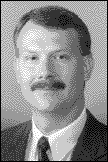From the Executive Director – Mar-Apr 2003
 From the Executive Director
From the Executive Director
Legacy
Like most parents, I am concerned about the legacy that I am leaving my children. Not what money or possessions will make up my estate, but what I am teaching my kids, both by word and example. The ultimate proof comes as they grow older and face the opportunities and challenges of adulthood. Depending on how long I live, I may or may not know the ultimate result of my legacy. It does not hurt, however, to stop once in a while and assess your ongoing progress.
As swine veterinarians, we too should be concerned about the legacy we are leaving to the veterinarians of the future and the future swine industry. Currently, there is a growing concern about the supply of food animal veterinarians. There appears to be an emerging consensus that the demand is exceeding the supply. The anecdotal evidence of unfilled positions in food animal practice also supports this position.
The AASV began to actively address this issue over a year ago. So far, we have found that there are no easy answers. Intertwined with this subject of supply and demand is the issue of the selection of students for admission to colleges of veterinary medicine. Also intertwined is the question of whether we are adequately educating veterinary students for careers in the swine industry. It is not surprising that superimposed on this debate is the issue of time and resources.
The issue of time is that today’s decisions are based on tomorrow’s needs. The veterinary medical education system cannot be easily or quickly manipulated to adjust for changes in demand. The supply pipeline for today’s graduate started at least 4 years ago. You might argue that the pipeline started well before entrance to veterinary college. However, for the sake of simplicity and from a standpoint of assessing the adequacy of education and training, we can use the beginning of the professional curriculum as a starting point. From there you can delve into the dilemma of how much and what kind of swine-specific education is needed to make a swine veterinarian.
The issue of resources then arises to question whether a college of veterinary medicine can justify committing adequate resources to a small and perhaps shrinking number of students interested in learning about swine health and production. These resources include both faculty and time in an already packed curriculum. With budget restrictions becoming the norm in many states, it is only a matter of time in some colleges before the swine curriculum contracts to a level that is merely adequate for students to pass their national board and state licensing examinations. This is not a level that stimulates a student to even look seriously at a career as a swine veterinarian, let alone prepare for this type of career.
The education of veterinary students is not the responsibility of the colleges alone. The whole profession needs to step up to the task. I am a firm believer in veterinary students learning by observing and participating with veterinarians practicing medicine in everyday clinical settings. There is nothing like the experience of a real and practical situation to stimulate an avid student’s interest. Conversely, this same type of experience may turn negative if the example being set is inappropriate. Practitioners must be aware that students learn by observation. The expression of cavalier or reckless attitudes towards antibiotic use, patient care, or client relations does nothing but perpetuate a black eye that the profession can little afford during this time of increasing scrutiny of what we do in the swine industry.
As I considered the various issues tied together and surrounding the subject of veterinary education, I came to a few conclusions:
- Every college of veterinary medicine need not be everything to everybody, including the teaching of swine health and production;
- Students interested in careers in the swine industry need more and earlier practical experience to acclimate and prepare for entry into a dynamic industry;
- The profession and the industry must ensure that there are opportunities for new graduates to succeed and prosper;
- If we do not graduate an adequate number of well educated swine veterinarians, other professionals in the swine industry will be waiting (some anxiously) to take over our roles.
Practitioners and educators need to come together for candid discussions on the future of swine practice in order to set a course for educating the coming generations of veterinarians. There is plenty of accountability to go around. Let’s see if we can truly leave a legacy for which future veterinarians will thank us.